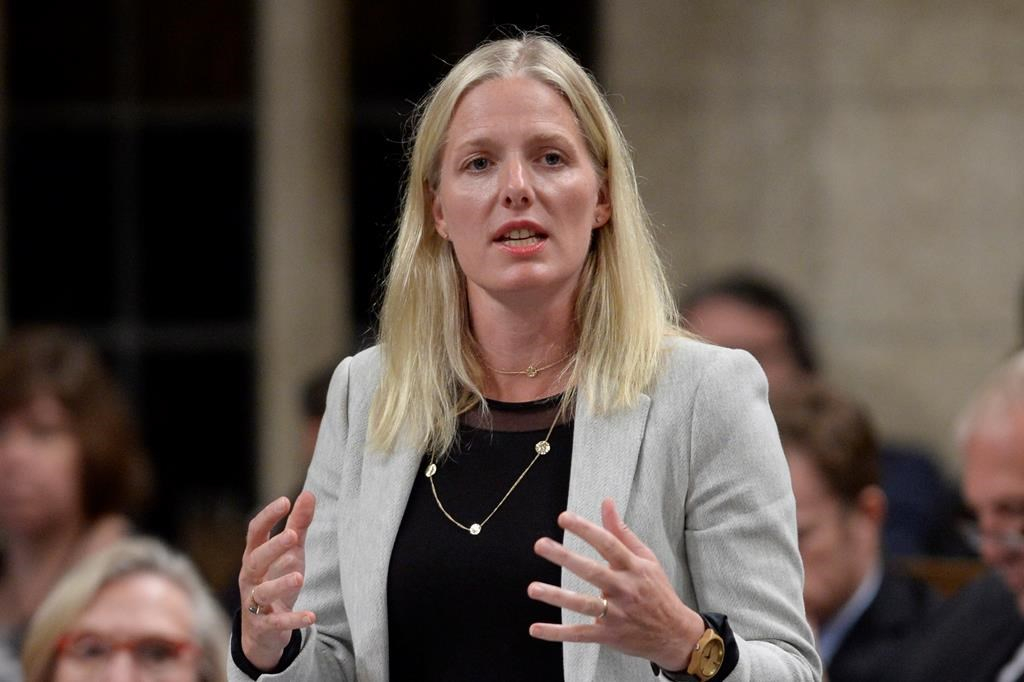Canada's overall greenhouse gas emissions will likely peak before 2020, says a new report, but achieving the country's 2030 targets is going to require much more work.
The independent analysis from Decarbonization Pathways Canada comes as federal Environment Minister Catherine McKenna joins an international climate summit in Marrakech, Morocco, where the mechanics of last year's Paris climate accord are being negotiated.
Delegates at this year's United Nations-sponsored COP22 heard Monday that global CO2 emissions have flattened out over the past three years, even as the planet appears poised to record another heat record in 2016.
The World Meteorological Organization released preliminary data through October that showed global temperatures are 1.2 degrees Celsius above pre-industrial levels.
The good-news, bad-news story applies to Canada as well, where emissions are projected to top out at about 720 million tonnes by the end of this decade. But they won't easily be clawed down to Canada's international 2030 commitment of 522 million tonnes, given the lack of further policy measures and a growing economy.
"As current policy flatlines past 2020 and GHGs rise with the economy, the NDC (target) gap widens," economists Dave Sawyer and Chris Bataille write in the policy paper commissioned by four major environmental organizations.
The escalating national floor price on carbon announced by the Trudeau government last month knocks only 18 million tonnes off Canada's 170-million tonne gap in 2030, according to their analysis.
But that gap potentially could be cut in half — by another 68 million tonnes — if Canada can realize emissions trading credits under the Paris Accord.
Delegates in Marrakech say Canada's negotiators over the past week have been heavily focused on Article 6 of the Paris agreement, which addresses emissions trading between countries.
Quebec and Ontario have joined a cap-and-trade market with California, and the policy paper says GHG "imports" by Canada's two largest provinces could account for 68 million tonnes of reduced emissions in Canada's ledger by 2030.
However "the modalities to allow such transfers to be fully recognized have yet to be worked out," says a footnote in the analysis — which is what Canadian negotiators are addressing at COP22.
A spokeswoman for McKenna noted Monday from Marrakech that the minister "played a leadership role" in pushing the Article 6 chapter in Paris last December.
"Market-based solutions are certainly part of the equation to grow a cleaner global economy," McKenna said an emailed statement.
Youth delegates at Marrakech say they're concerned that Canada wants to use international credits in an effort to hit its emissions target rather than reducing greenhouse gases at home.
Emissions traders counter that the planet has only one atmosphere, and all emission reductions help.
To that end, a study published in the journal Earth System Science Data says global CO2 emissions from fossil fuels and industry are projected to grow just 0.2 per cent this year.
That would mean emissions have levelled off at about 36 billion tonnes in the past three years even though the world economy has expanded, suggesting the historical bonds between economic gains and emissions growth may have been severed.
However, the authors of the study cautioned it's unclear whether the slowdown, mainly caused by declining coal use in China, is a permanent trend.
"It is far too early to proclaim we have reached a peak," said co-author Glen Peters, a senior researcher at the Center for International Climate and Environmental Research in Oslo.
Chinese emissions were down 0.7 per cent in 2015 and are projected to fall 0.5 per cent in 2016, the researchers said — noting Chinese energy statistics have been plagued by inconsistencies.
Peters said it's unclear whether the Chinese slowdown was due to a restructuring of its economy or a sign of economic instability, but the unexpected emissions reductions "give us hope that the world's biggest emitter can deliver much more ambitious emission reductions."
China, which accounts for almost 30 per cent of global carbon pollution, pledged to peak its emissions around 2030 as part of the Paris pact. Many analysts say China's peak is likely to come much earlier — and may already have occurred.
Even if China's emissions have stabilized, growth in India and other developing countries could push global CO2 levels higher again. India's emissions rose five per cent in 2015, the study said.
The election of Donald Trump as president of the United States — the world's No. 2 carbon polluter — could also have an impact.
U.S. emissions fell 2.6 per cent last year and are projected to drop 1.7 per cent this year, as natural gas and renewables displace coal in power generation, the study showed. But it's unclear whether those reductions will continue under Trump.
Obama's climate envoy, Jonathan Pershing, said Monday that China and other countries would move forward on climate action even if the U.S. reverses course.
"I'm hearing the same from the Europeans," he said.
"I'm hearing the same from the Brazilians. I'm hearing the same from Mexico, and from Canada, and from smaller nations like Costa Rica and from Colombia."
— With files from The Associated Press





Comments